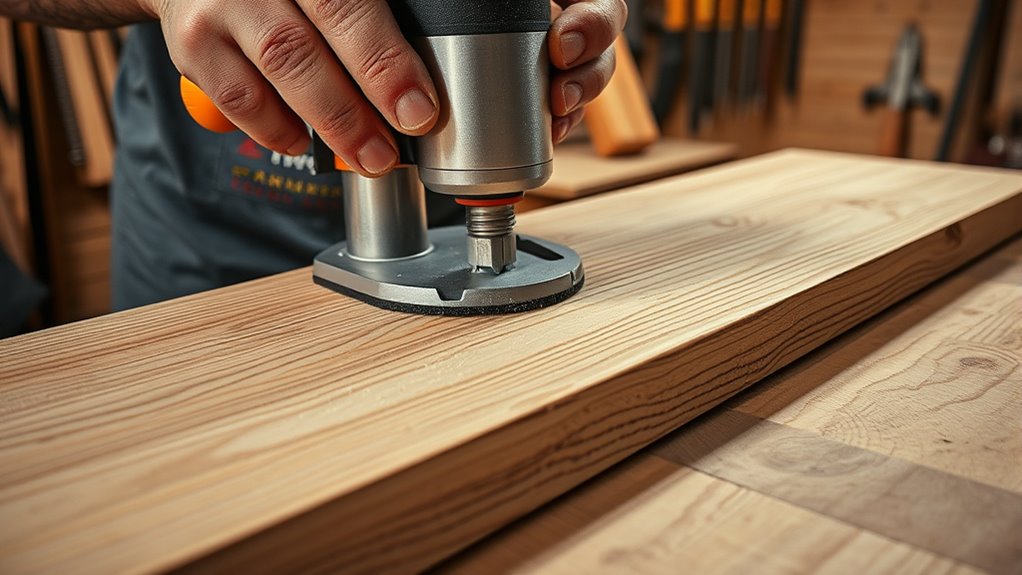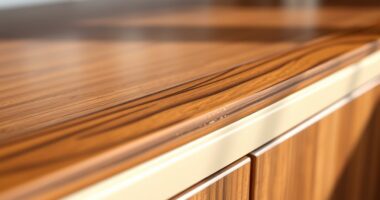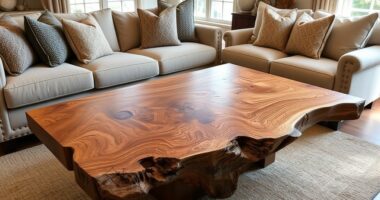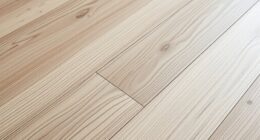To properly use a router in woodworking, start by choosing the right type and bits for your project, ensuring compatibility. Secure your workpiece tightly and set the correct depth for your cut, making shallow passes if needed. Rout against the grain for cleaner edges and maintain steady, controlled feed pressure. Always follow safety precautions, wear protective gear, and keep your tools well-maintained. For expert tips and step-by-step guidance, keep exploring how to master this versatile tool.
Key Takeaways
- Choose the right router and bits based on your project needs and material, ensuring compatibility with shank sizes.
- Securely clamp workpieces and utilize guides or fences for precise, safe cuts.
- Adjust depth gradually, using stops and reference samples, and plan multiple passes for clean results.
- Feed the router against the bit’s rotation and maintain steady pressure to prevent kickback and ensure control.
- Prioritize safety with protective gear, regular tool maintenance, and proper techniques to prolong tool life and ensure safety.
Choosing the Right Router and Bits for Your Project
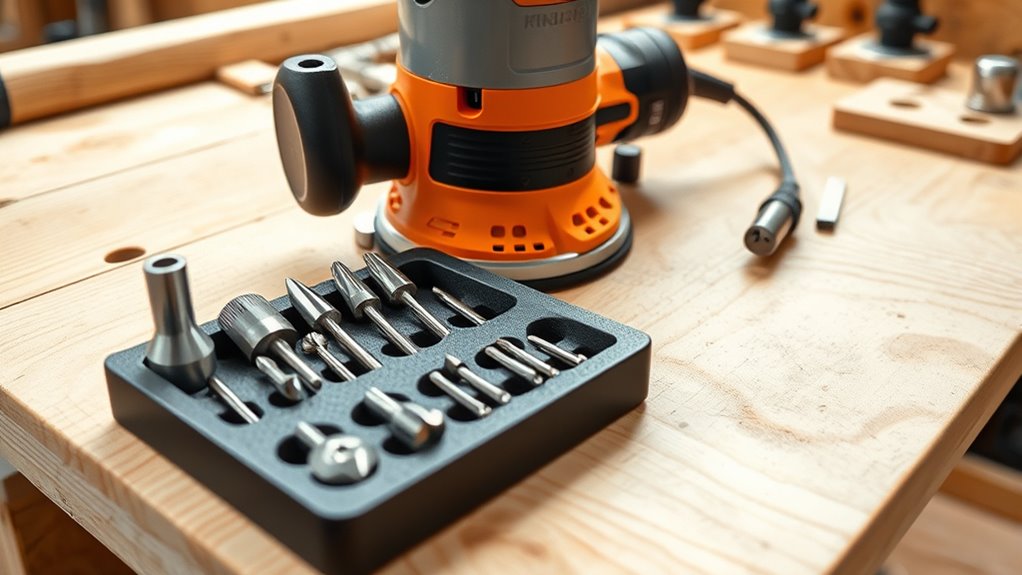
Selecting the right router and bits is essential for achieving clean, efficient results in your woodworking projects. First, identify your project’s needs. Fixed base routers are simple and great for edge work, ideal for beginners. Plunge routers offer adjustable depths, perfect for inlays and carvings. Combination routers provide versatility, combining fixed and plunge features for professional use. Trim routers are compact, excellent for detailed edge trimming and laminate work. Consider your project size and power requirements: larger, higher horsepower routers handle thicker materials, while smaller or cordless models suit light tasks. Choose bits compatible with your router’s shank size—1/4″ for detailed work, 1/2″ for heavy-duty cuts. Selecting the correct router and bits guarantees safety, precision, and efficient craftsmanship. Understanding historical farmhouses can also inspire unique design choices and craftsmanship techniques in woodworking projects. Additionally, paying attention to dust collection systems can improve your workspace cleanliness and safety.
Mastering Routing Techniques and Directional Rules
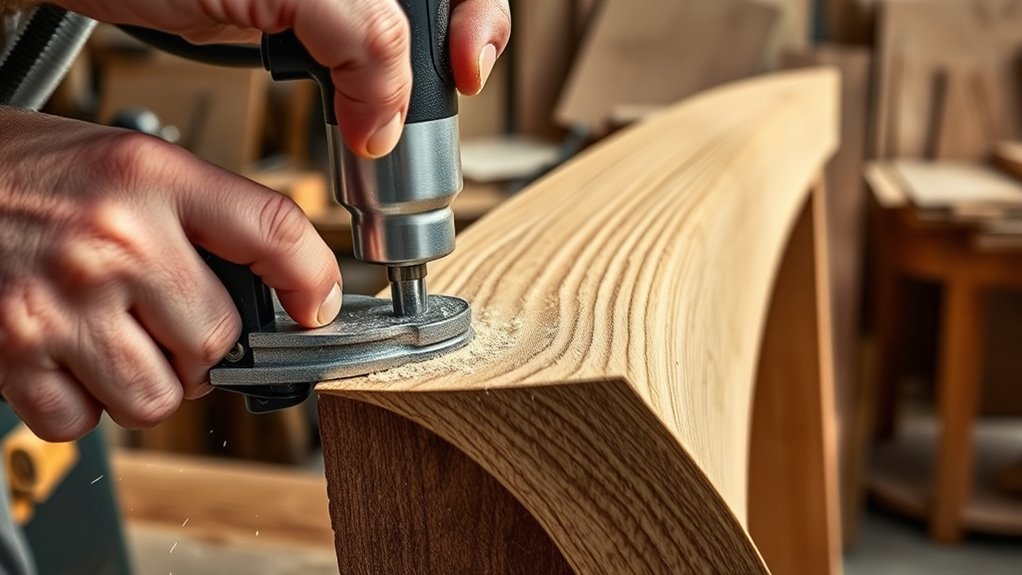
Mastering routing techniques and understanding proper directional rules are essential for achieving clean, accurate cuts and ensuring safety. Always feed the router against the bit’s rotation to prevent kickback and control material movement. Using AI tools can assist in planning precise cuts and design patterns, improving overall project accuracy. Identify the cutting edge on your bit to determine the correct feed angle. Clamp your workpiece securely to avoid movement and reduce vibration, which causes chatter and rough finishes. Rout against the grain first for cleaner edges, then refine with the grain if necessary. Maintain a firm grip and balanced pressure to minimize chatter and achieve smooth cuts. Use proper templates and support bases when performing flush trimming. For decorative profiles, adjust bit depth carefully and back-route to improve finish quality. Being familiar with emotional support and their features can help in selecting the right equipment for your space and project goals. Understanding celebrity transformations can inspire innovative design ideas and techniques in woodworking projects. Following these directional rules ensures precision and safety throughout your project.
Managing Depth, Passes, and Material Control

Controlling the depth of cut, number of passes, and material feed rate is essential for achieving accurate, clean results with your router. To set the depth, adjust the router’s depth stop or turret stop, often using reference samples for calibration. For plunge routers, use knobs and levers to fine-tune the plunge depth.
Managing multiple passes involves setting incremental stops, taking shallow cuts each time to reduce strain and improve finish. Always feed material at a steady, controlled rate—too fast can burn or damage the bit, too slow risks overheating.
Use guides or fences for stability, maintaining consistent pressure and angle. Precise depth setting, gradual passes, and controlled feed rate work together to produce clean, accurate cuts while extending tool life.
Securing Your Workpiece for Safe and Accurate Cuts

To guarantee safe and accurate cuts with your router, securing your workpiece firmly is essential. When your material moves during routing, it can cause uneven cuts or even kickback, risking injury. Use clamps or a vise to hold the workpiece steady on your work surface. Ensure the clamps are tight enough to prevent any shifting, but avoid over-tightening, which can damage the material. If working with large or irregularly shaped pieces, consider using a sacrificial backing or additional supports to keep everything stable. Double-check that the workpiece is secure before starting the router. Properly clamped workpieces not only improve cut precision but also enhance safety, giving you confidence to focus on making clean, accurate cuts without concern for slips or movement. Additionally, understanding dog names can help personalize your workspace or tools, making your woodworking experience more enjoyable.
Maintaining Safety and Proper Tool Care

Ensuring safety and proper tool care is essential for a smooth and hazard-free woodworking experience. Always wear safety glasses to protect your eyes from flying debris, and use hearing protection like earmuffs or earbuds to reduce noise. Dust masks or respirators help prevent inhaling wood dust, and gloves can add hand protection, but avoid loose clothing that could catch in the router. Regularly inspect and maintain your router and bits, ensuring they’re sharp and properly tightened. Store your tools in a dry place, and follow the manufacturer’s instructions to keep safety and performance superior. Additionally, understanding essential oils for safety can help in creating a healthier workshop environment by reducing airborne contaminants. Incorporating fatherly guidance into your safety routines can also serve as a reminder of the importance of careful and attentive work habits. Proper tool maintenance is crucial for ensuring longevity and optimal performance of your equipment, and consulting glycolic acid benefits for skin resources can offer insights into effective exfoliation and skin care practices. Moreover, staying informed about precious metals investment can inspire more mindful decision-making in your workshop investments and safety practices.
Frequently Asked Questions
How Do I Troubleshoot Common Router Performance Issues?
When troubleshooting common router performance issues, start by inspecting your bits for wear or resin buildup, cleaning and sharpening them as needed.
Check that bits are tightened properly and use the correct collet size.
Adjust your feed rate and router speed according to the material and bit size to prevent burning and chatter.
Confirm your electrical supply is stable and grounded to avoid motor problems.
Regular maintenance and secure fixtures help keep your router running smoothly.
What Are the Signs of a Dull or Damaged Router Bit?
Imagine your router bit as a sword in a duel; if it’s dull or damaged, your cuts become sluggish and imprecise. You’ll notice burn marks, rough chips, and irregular surfaces on your workpiece.
Visually, the bit might have nicks, corrosion, or wobbling. If you feel vibrations or increased heat, it’s a sign it’s time to examine or replace the bit.
Keeping it sharp ensures smooth, safe cuts every time.
Can I Use a Router for Metal or Plastic Materials?
You can’t effectively use a standard wood router for metal or plastic materials. Metal requires industrial-grade bits, coolant, and lower speeds, which your router can’t provide.
For plastics, you need specialized bits and controlled speeds to prevent melting or chipping. Attempting to cut metal or plastic with a wood router risks damage to the tool, safety hazards, and poor results.
Instead, consider dedicated tools like CNC routers, milling machines, or laser cutters.
What Precautions Are Needed When Routing Near Delicate Surfaces?
When routing near delicate surfaces, you need to take extra precautions to prevent damage. Use protective barriers like masking tape or veneer, and keep your router bits sharp for clean cuts.
Maintain a controlled feed rate and secure your workpiece firmly. Monitor the bit depth carefully to avoid over-penetration.
Additionally, use push blocks for safety, and always stay alert to make certain you don’t inadvertently harm sensitive surfaces during routing.
How Do I Achieve a Smooth Finish After Routing?
To get a smooth finish after routing, start by hand-sanding your work with progressively finer grits—from 120 to 320.
Use a block plane or scraper to remove any remaining tool marks on edges and curves.
Clean the surface with a tack cloth or compressed air to remove dust, then apply your finish carefully, using wet-sanding with high-grit sandpaper for an ultra-smooth, professional look.
Conclusion
Remember, mastering your router isn’t just about tools—it’s about cultivating patience and attention to detail. When you approach each cut with care and respect, your projects will reveal their true beauty. Embrace every challenge as a gentle whisper guiding you toward craftsmanship. With practice and mindfulness, you’ll find that the journey itself becomes as rewarding as the finished piece, gently guiding you toward mastery and confidence in your woodworking endeavors.
